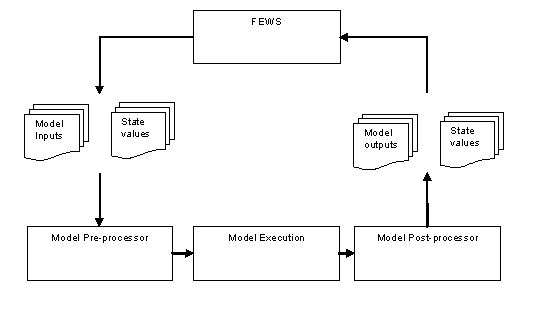Interactive editing of model states
Several operational forecasting systems utilise conceptual hydrological models for calculating the response of a catchment to rainfall. These models typically contain a number of parameters and state variables. A common requirement within the forecast process is the updating of state variables so that the results of the models is closer to the observed behaviour. The updating of states on the basis of observed errors is often referred to as data assimilation.
There are methods available that allow for the updating of states algorithmically, including for example Kalman Filters, empirical state correction methods etc. Another approach is the direct updating of state variables through manual intervention.
The approach taken in that state variables are considered as time series of variables and FEWS handles these as it does any other time series. The evolution of state variables can then be easily plotted against time as can for example the time series of resulting discharge. When a state variable needs to be amended, the changed values are saved as non-equidistant values at the time of the change. When running the model these values are imported into the model and at the time indicated used to overrule the value calculated internally.
To be able to use the state modifiers functionality, the adapter to the model for which the states are to be modified must have the ability to take in the time series of amended values and overrule those used in the internal state. Additionally the model and its adapter should be able to export the values of calculated state variables as a time series. The figure below illustrates the exchange of time series of model inputs & state values to the external model, as well as the return of model outputs and state values.
State Editor Display
The State editor display supports the user in amending time series of state variables. The amended data are then passed to the model through the model adapter to allow insertion into the state and subsequent change of response on running the model.
The state editor display is in principle independent of the DELFT-FEWS system, and has been developed as a web service client. Exchange of data with the DELFT-FEWS database makes use of a web service data exchange protocol. To the normal user, however, the display appears as an integrated part of the system.
The state editor display contains four main sections
• In the main window a graph is shown of the selected state variable and the response of the model. Only one variable is shown at a time for simplicity. The arrows on the bottom right can be used to navigate to the other variables.
• The panel below the main window shows each of the state variables. For each a slider control is available which allows the user to set the desired value. The slider controls include reference values of the climatology maximum and minimum (red lines), average (green lines) and the original values (blue line).
• A tree view on the left showing all the models for which states are available.
• A panel on the bottom left showing times at which states are available in the database for the selected model.
